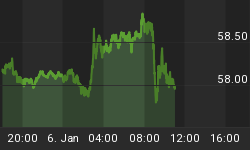It was touch and go for a while, but our fundamental bond model has finally yielded a sell signal. The model is now in congruence with the technical picture, which has been looking bearish. As we know, the Federal Reserve has been buying bonds at the long end of the yield curve. Figure 1 is a weekly chart of the i-Shares Lehman 20 plus year Treasury Bond Fund (symbol: TLT).
Figure 1. TLT/ weekly
Point 1 on the chart represented a break out from a long and deep base. Price went on to break above the next key pivot at 128.52 (resistance level). But price quickly closed back below this level (which was new support then) 4 weeks ago, and this becomes a double top. We now find price back at the original break out point and the rising 40 week moving average. Failed breakouts can be ominous, and the failure at 128.52 has led to price weakness. But in the bigger picture sense, price is only back to testing the original breakout point in the 120.76 to 122.27 support zone. In my opinion, this appears to be the key area.
One point needs clarification. This "sell" signal doesn't mean that I am bearish on Treasury bonds. Many analysts have been calling for the bond bubble to burst for more than 2 years now, and they have been wrong. So anytime in the recent past that there has been weakness in bonds, the blogs are filled with stories of the bond bubble bursting. I don't see this point in time as the start of a new bear market in Treasury bonds. My position on Treasury bonds is neutral. I don't expect them to go up nor do I expect them to go down much.
As far as the significance of a sell signal in Treasury bonds, this likely represents the fact that QE3 is off the table. For the past several years, Treasury bonds have run up in price in anticipation of more QE from the Federal Reserve. Yes, there was economic weakness, but weakness in the economy has meant Fed intervention, which has meant asset purchases (i.e., primarily purchases of bonds to lower interest rates). The economy has been improving albeit sluggishly, and with equity markets pushing new cyclical highs, there seems little reason for central bank intervention at present. Over the past 2-3 months, equity markets have risen on the hope of QE3, so one has to wonder that if QE3 isn't coming when will the equity markets get the word.
















